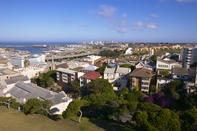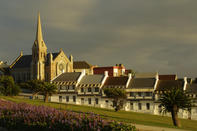A Historical Overview of the Town
Touring through Port Elizabeth is well worth your while. If you’re interested in architecture, head to Market Square for a historical overview of the town. This is the location of the City Hall, the Old Post Office, the Library Building and the Feather Market Hall.

The Campanile watch tower, built in the 1920’s to commemorate the arrival of the 1820 settlers, can also be reached from the square. These gorgeous old buildings are a charming assortment of Victorian, Gothic, Edwardian and Art Nouveau styling, and a typically dour statue of Queen Victoria casts her benediction over the whole piazza.
Nearby, you’ll also find the world’s only memorial to Prester John. Prester John is a mythological figure, dating back more than 500 years. He was reputedly a white Christian emperor who improbably ruled a powerful and wealthy tribe, somewhere in Africa. Making contact with Prester John was actually the ostensible reason many European nations propounded for exploring Africa in the first place. But no trace of the elusive Emperor ever materialised.
The existence of Prester John seems to have been conjured up by generations of Europeans, who just could not conceive of a black civilisation that was advanced enough to account for the inexplicable supplies of gold that had been coming out of the dark continent for the last 1000 years.
Fantastically Old Fashioned

From Baakens Street, you can turn up towards the Donkin Reserve. This is a large, green commons on the top of a hill, which looks down on the harbour and city centre below. The reserve is dominated by an old lighthouse, which can be visited, and the large, grey concrete pyramid that functions as the Elizabeth Donkin Memorial.
If you don’t mind the wind, this is a good place to pull up a park bench for a few moments of R+R - rest and recuperation. The main tourist bureau is at the foot of the lighthouse. Around the park are a number of interesting old buildings. The Edward Hotel is a particularly fine example of late-Victorian / early Edwardian architecture.
Built about 100 years ago, the hotel has a wonderful facade lined with lattice-work balconies and domed windows. The interior of the Edward is fantastically old fashioned, and tea in the faded Palm Court is a treat for lovers of retro-dining.
At the Other End
At the other end of the Donkin Reserve, there stands a row of restored terrace houses, built between 1860 and 1880. This whole street has been declared a national monument. An African restaurant, with incongruous orange-coloured walls, and the Victorian bulk of a Presbyterian Church also hold court around the green.
An excellent walking tour, The Donkin Heritage Trail, will guide you through the historical heart of the city centre, and an interpretative booklet can be bought from the tourist bureau. For more modern history, visit the South End Museum on the outskirts of the Central Business District CBD, and pick up a walking tour booklet that will lead you through P.E.’s apartheid past.
The South End area is akin to District Six in Cape Town, or Sophiatown in Joburg, as it was the scene of many bitterly contested forced removals in the 1960’s.
By David Fleminger